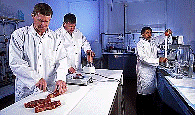United States Department of Agriculture: Agricultural Research Service, Lincoln, Nebraska

Roman L. Hruska U.S. Meat Animal Research Center: Reports
Date of this Version
1985
Document Type
Article
Abstract
It is generally recognized that intact bovine males gain weight faster and require less feed per unit of gain than castrate bovine males. Further, carcasses from intact bovine males have a higher percentage of retail or edible product, but meat from intact males is generally evaluated slightly lower on palatability characteristics, particularly tenderness, than carcasses from castrate bovine males. It has been suggested that much of the advantage of intact vs castrate for rate of gain, efficiency of gain, and composition of gain may be expressed by an age of about 1 year and the disadvantages, including aggressive male behavior, that result in reduced rate and efficiency of gain, begin at about 1 year of age (at or immediately after puberty). Thus, there was need to determine the effects of castration at about 1 year on rate of gain, efficiency of gain, composition of gain, meat characteristics, and behavioral characteristics. Reports have shown that, when the anabolic agent zeranol [6-(6,10-dyhydroxyundecyl)-B-resorcyclic acid-d-lactone] is implanted in intact male calves at or before weaning, rate of gain is increased and rate of testicular growth is decreased. These experiments were conducted to determine the effects of castration and zeranol implants at 13 months of age on rate of gain, efficiency of gain, behavioral characteristics, and carcass and meat traits of bovine males.


Comments
Published in Beef Research Program Progress Report (1985) No. 2: 36-40